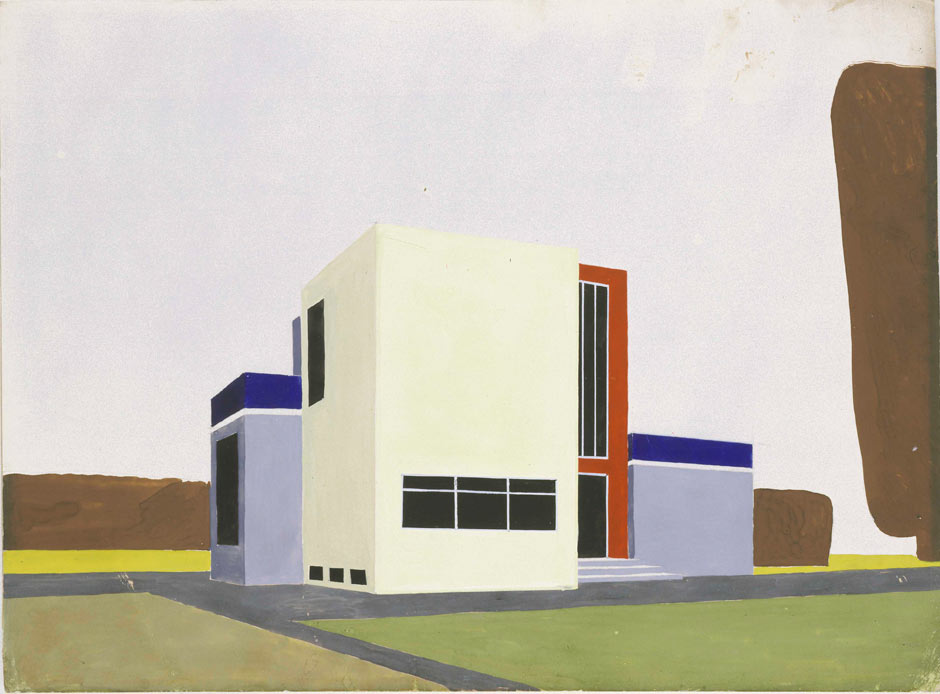 |
| Farkas Molnár’s Design for a family house (1922). |
The school of Bauhaus first emerged in 1919 in Weimar, Germany as the school of Art and Craft. Their focus was to unify fine art, craft and technology. As a funder for Bauhau, one of Walter Gropius goal was to create school curriculum that expand the fine art and craft such as typography, pottery, painting, architect, furniture design. As the machinery age prosperous, the school began to implement designs for the mass-production using industrial material like steel and glass. Indirectly influence by the art movement of the time like Futurism and Constructivism, Bauhaus school not only see the machine age as a force for form and function but they also began to simplify and rationalize their design into simple geometric shapes and primary color. Bauhaus school faces political force of the Nazi in 1925 and they relocate to Dessau, Germany. Gropius designed the new school architecture from simple form, incorporated industrial element like the steel fames and curtain walls of glass. The new school focused on the industrial aesthetic with concrete and steel and a curtain wall of glass that we now recognize as the basic components of modern architecture. The idea of “less is more” also began to emphasize.
After the rise of Hitler, Bauhaus school is closed as their concept is modern and radical that challenged the conservative and political regime. Many of the faculties and artists of this school began to migrate over into Western Europe and United State. Their ideas and concepts of simple form follow function were widely spread as they began to teach in universities. One of the contributions of the Bauhaus school is influenced on the field of architect and furniture design. The use of metal fame, glass and concrete gives modern architecture an airy feel that are economically practical. We see skyscraper still directly influence by the Bauhaus aesthetic of industrial revolution. The use of metal fame and glass open up the space to create an unobtrusive view without the heavy weight, creating volume without the mass. Modern furniture designer of the mid-century were greatly influence by Bauhaus. The idea of simple form and color can be manufacture in mass-production seem appealing to furniture designers. Furniture no longer a decorative element but practical in the clean frame, simple line, minimalist, none essential form, reduced color, geometric shapes, unobtrusive view that are pleasing to the eye yet maximize the function.
Mid-century architect and furniture designer Le Corbusier embraced the concept of clean, modern design that form follows function. Just like many other architect, Le Corbusier designed furniture to compliment his architecture. As an urban designer, he also concerned about minimal form that maximize the function of modern need.
 |
| Le Corbusier Pony Chaise Lounge LC4 |
Bauhaus modern concept gave us urban skyscrapers that are heavy in volume without the mass. Their concepts of basic design are still being studied under academic of the fine art and architecture. Looking at a mid-century, we still see a fresh new look despite time gap in time because fundamental of design will prevail aesthetic. Basic form and color will maximize its function as well as aesthetic as minimalist see “less is more”.
1. Design within Reach: Le Corbusier
http://www.dwr.com/category/designers/h-l/le-corbusier.do
2. Hunter, Sam, John M. Jacobus, and Daniel Wheeler. Modern Art: Painting, Sculpture, Architecture, Photography. 3rd ed. Upper Saddle River, N.J: Prentice Hall, 2004. 206. Print
3. Quick History: The Bauhaus and its Influence
http://www.apartmenttherapy.com/post-241-93344
No comments:
Post a Comment